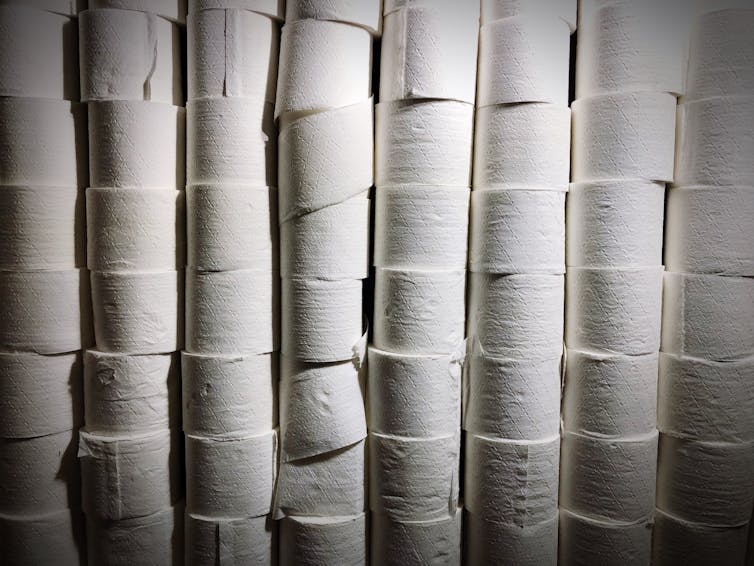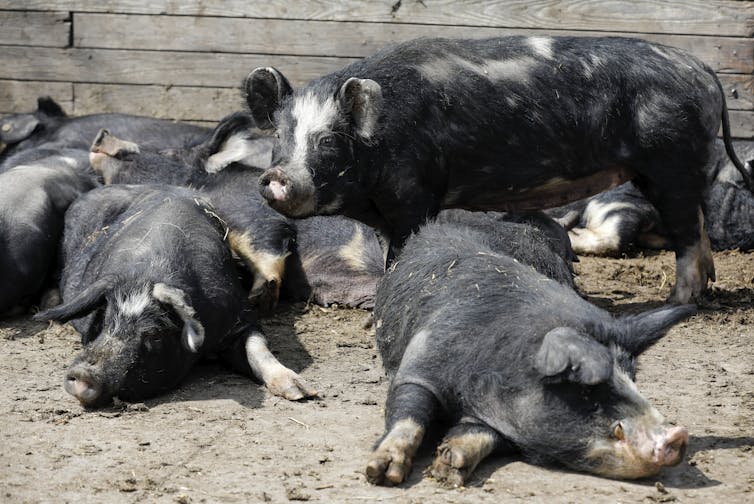Why farmers are dumping milk down the drain and letting produce rot in fields
- Written by Elizabeth Ransom, Associate Professor of International Affairs & Senior Research Associate Rock Ethics Institute, Pennsylvania State University
Many Americans may be surprised and confused to see farmers dumping milk[1] down the drain or letting vegetables rot[2] in their fields.
Why would they be destroying food at a time when grocery stores[3] and food pantries[4] struggle to keep pace with surging demand during the coronavirus pandemic?
As sociologists[5] with a specialty in agriculture[6] and food[7], we study how the structure of the food system affects people’s lives and the environment. Seeing food destroyed at a time when people are going hungry[8] highlights both short- and long-term problems with this system.
 Food and toilet paper have more in common than you think.
Rodney Stubina/EyeEm/Getty Images
Food and toilet paper have more in common than you think.
Rodney Stubina/EyeEm/Getty Images
A tale of two supply chains
Surprisingly, the supply chain for food bears a striking similarity to that of another product that has experienced shortages: toilet paper[9].
Like the toilet paper market, the food industry has two separate supply chains for consumer and commercial use. On the consumer side are grocery and convenience stores that focus on small purchases. The commercial side represents restaurants and institutions such as schools, prisons, hospitals and corporate cafeterias that purchase large quantities of foods in bulk. Ultimately, commercial institutions purchase in sizes that exceed the storage capacity of most households and food pantries.
While the commercial and the consumer supply chains are different, there are some commonalities: Both are complex, cover long distances and rely on just-in-time production. Both are also increasingly concentrated, meaning that there are only a few companies[10] between farmers and consumers that process and distribute raw agricultural goods into edible food. For example, on the commercial side, Sysco[11] and U.S. Foods control an estimated 75% of the market[12] for food distribution.
These characteristics make the supply chains more vulnerable[13] to disruptions.
In 2018, over half of all U.S. spending[14] on food was on the commercial side of the supply chain. The introduction of social distancing measures in March[15] forced schools, corporate cafeterias and many restaurants to close. As a result, a lot of food intended for commercial use no longer had a buyer.
 Meat plant closures has created a bottleneck for processing.
AP Photo/Charlie Neibergall
Meat plant closures has created a bottleneck for processing.
AP Photo/Charlie Neibergall
Where the supply chains diverge
To understand why this food can’t readily be diverted to consumers, let’s take a closer look at the supply chains for meat, vegetables and milk. With each category, there are different reasons.
Vegetable farmers, for example, have a lot of crops growing in their fields intended for commercial buyers like schools, restaurants and cruise lines[16], which are no longer purchasing these products.
But a worsening[17] labor shortage[18] makes it a lot harder to harvest or pick their crops and package them for consumers.
So a combination of plunging commercial demand, not enough low-wage yet skilled laborers, falling prices[19] and a short window in which to pick vegetables means it has become cheaper to simply let them rot in the fields.
As for meat, restaurants typically order[20] larger cuts and use more of the pricier parts like tenderloins. In contrast, much of the meat purchased on the consumer side is sold in “case-ready” packages[21], and ground beef is far more common.
So in general, commercial buyers tend to buy parts of the cow or pig that consumers simply don’t prepare at home. But what’s more, meat plant closures[22] due to COVID-19 outbreaks are creating a bottleneck for slaughtering and processing animals, which also have a short window before they’re past their prime. As a result, producers, particularly pork farmers, are debating whether to feed and care for their animals past their prime or simply euthanize them[23].
Milk is even more complicated when it comes to how it flows along the food chain.
First, there’s no stopping cows giving milk; udders that are full must be emptied daily. The only question is where that milk will go.
Restaurants and organizations like schools purchase nearly half[24] of all milk, butter and other dairy products processed in the U.S. Pizzerias alone take nearly a quarter of all U.S. cheese production[25].
With many of these customers closed or cutting their purchases, there’s lots of excess milk. Unfortunately, processors do not have the equipment to package that milk into smaller containers for grocery stories and retail use.
As for converting more milk into dairy products with longer shelf lives like cheese, there was already a glut of mozzarella and other cheese plugging up cold storage space[26]. And despite a rise in takeout pizza, overall demand for cheese[27] has “dropped like a rock,” according to trade industry sources.
That has left dairy farmers with little choice but to dump excess milk[28] into manure ponds and ditches.
 A quarter of all cheese makes its way to a pizza.
Karl Tapales/Getty Images
A quarter of all cheese makes its way to a pizza.
Karl Tapales/Getty Images
A longer-term problem
Many states are working on short-term solutions to bridge the gap between the two supply chains.
Nebraska[29] is temporarily allowing restaurants to sell unlabeled packaged foods to customers, Texas[30] is pushing restaurants to prepare food care packages for at-risk families, and many other states have changed their health regulations to allow restaurants to repackage products[31] into smaller quantities to sell to the public.
In addition, the U.S. Department of Agriculture plans to begin purchasing US$3 billion in fresh produce, dairy and meat[32] to support farmers and eventually distribute it to food pantries and other organizations feeding Americans in need.
Although helpful in the short term, we believe a longer-term problem that needs to be addressed is how concentrated food supply chains have become, which has made them less nimble in adapting to disruptions like a health pandemic.
References
- ^ dumping milk (www.cbsnews.com)
- ^ vegetables rot (www.cbsnews.com)
- ^ grocery stores (www.cnn.com)
- ^ food pantries (www.cbsnews.com)
- ^ sociologists (scholar.google.com)
- ^ agriculture (scholar.google.com)
- ^ food (scholar.google.com)
- ^ are going hungry (www.theguardian.com)
- ^ toilet paper (marker.medium.com)
- ^ few companies (ag.purdue.edu)
- ^ Sysco (www.forbes.com)
- ^ estimated 75% of the market (www.ftc.gov)
- ^ vulnerable (theconversation.com)
- ^ over half of all U.S. spending (www.ers.usda.gov)
- ^ introduction of social distancing measures in March (www.nytimes.com)
- ^ cruise lines (www.politico.com)
- ^ worsening (www.wsj.com)
- ^ labor shortage (www.fb.org)
- ^ falling prices (economictimes.indiatimes.com)
- ^ typically order (www.dtnpf.com)
- ^ case-ready” packages (www.meatinstitute.org)
- ^ meat plant closures (www.usatoday.com)
- ^ simply euthanize them (www.dtnpf.com)
- ^ nearly half (www.syracuse.com)
- ^ U.S. cheese production (www.cnbc.com)
- ^ cold storage space (www.wbur.org)
- ^ overall demand for cheese (www.farmprogress.com)
- ^ but to dump excess milk (www.bloomberg.com)
- ^ Nebraska (governor.nebraska.gov)
- ^ Texas (gov.texas.gov)
- ^ repackage products (www.beefmagazine.com)
- ^ US$3 billion in fresh produce, dairy and meat (www.commondreams.org)
Authors: Elizabeth Ransom, Associate Professor of International Affairs & Senior Research Associate Rock Ethics Institute, Pennsylvania State University

